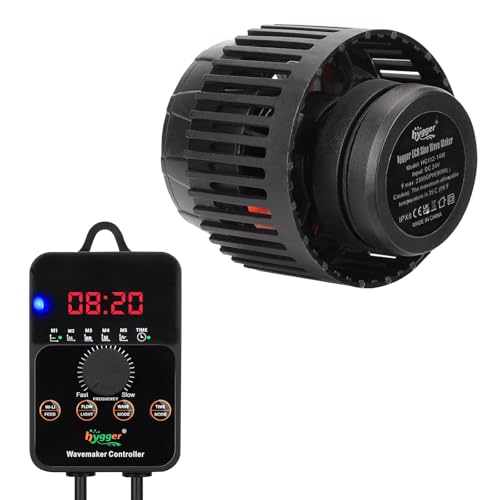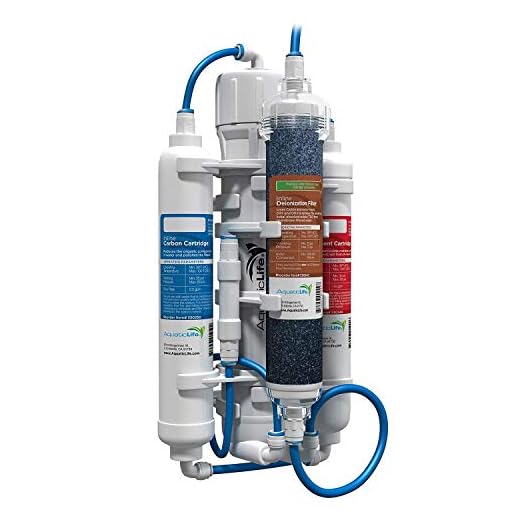Reef
Blog
How to make a saltwater fish tank

Setting up a saltwater fish tank can be an exciting and rewarding experience. Whether you are a beginner or an experienced fishkeeper, creating a thriving marine ecosystem requires careful planning and attention to detail.
Choosing the right equipment and materials is crucial for the success of your saltwater fish tank. You will need a tank of appropriate size, filtration system, heater, lighting, and a powerhead or wave maker to create water movement. Additionally, you will need live rock, aragonite sand, and salt mix to prepare proper saltwater.
Setting up the tank starts with rinsing the tank, then placing the live rock and aragonite sand. The live rock will provide a natural habitat for beneficial bacteria and also serve as a hiding place for your fish. The aragonite sand will create a natural look and help maintain a stable pH level.
Cycling the tank is an essential step before adding any fish. This process allows beneficial bacteria to establish and break down harmful ammonia and nitrite. To cycle the tank, add ammonia source such as fish food or pure ammonia, and test the water regularly until ammonia and nitrite levels reach zero.
Remember, patience is key during the cycling process as it may take weeks for the tank to fully cycle.
Planning a Saltwater Fish Tank Setup
Setting up a saltwater fish tank can be an exciting and rewarding experience. However, it requires careful planning to create a healthy and thriving environment for your fish. Here are some key steps to consider when planning your saltwater fish tank setup:
Determine the Tank Size
The first step in planning your saltwater fish tank setup is determining the appropriate tank size. Saltwater fish require more space than freshwater fish, so it’s important to choose a tank that will provide enough room for your fish to swim and thrive. A general rule of thumb is to allow for one gallon of water per inch of adult fish length.
Choose the Right Location
Once you have determined the tank size, you need to choose the right location for your saltwater fish tank. It’s important to place the tank away from direct sunlight and drafts, as these can cause fluctuations in temperature and water quality. You should also ensure that the floor or stand can support the weight of the tank.
Consider the Filtration System
A filtration system is essential for maintaining a healthy saltwater fish tank. There are several types of filtration systems to choose from, including mechanical, chemical, and biological filtration. It’s important to select a system that will adequately remove debris and waste from the water, and provide sufficient oxygenation for your fish.
Choose the Right Lighting
Lighting is crucial for both the health and aesthetics of your saltwater fish tank. Different types of fish and corals require specific lighting conditions, so it’s important to research and choose the right lighting system for your setup. Proper lighting will promote the growth of beneficial algae and provide the necessary light spectrum for your fish and corals.
Consider Tank Decorations
Tank decorations not only enhance the visual appeal of your saltwater fish tank but also provide hiding places and territories for your fish. Live rocks, corals, and artificial decorations can all be used to create a natural and stimulating environment for your fish. It’s important to choose tank decorations that are safe for both your fish and the overall tank ecosystem.
Research Fish and Invertebrates
Before adding fish and invertebrates to your saltwater fish tank, it’s crucial to research their specific care requirements. Different species have different temperature, salinity, and dietary needs, so it’s important to create an environment that will support the health and well-being of your chosen fish and invertebrates.
Cycle and Test Water Parameters
One of the most critical steps in setting up a saltwater fish tank is cycling the tank and regularly testing water parameters. During the cycling process, beneficial bacteria will establish and convert toxic ammonia into nitrites and nitrates. It’s important to monitor water parameters such as ammonia, nitrites, nitrates, pH, and salinity regularly to ensure a stable and healthy environment for your fish.
Gradually Introduce Fish
When your tank is fully cycled and the water parameters are stable, you can start introducing fish to your saltwater aquarium. It’s important to start with hardy and small fish species and gradually add more fish over time. This will allow your tank to adjust to the increased bioload and minimize stress on the fish.
By following these steps and doing thorough research, you can plan and set up a saltwater fish tank that provides a beautiful and thriving environment for your fish and invertebrates. Remember to regularly maintain and monitor your tank to ensure the ongoing health and happiness of your aquatic pets.
Choosing the Right Tank
When setting up a saltwater fish tank, choosing the right tank is crucial for the health and well-being of your marine life. Consider the following factors to ensure you select the appropriate tank size and material:
Tank Size
The size of your tank will depend on the type and number of fish you plan to keep. Saltwater fish generally require more space compared to freshwater fish, so it’s important to provide your marine life with ample room to swim and thrive. A larger tank also provides more stability in terms of water quality and temperature fluctuations, which is essential for maintaining a healthy environment.
As a general guideline, a minimum tank size of 30 gallons is recommended for small to medium-sized saltwater fish, while larger species may require a tank of 100 gallons or more. Keep in mind that some fish, like tangs and angelfish, need plenty of swimming space and may require an even larger tank.
Tank Material
When it comes to tank material, there are two main options: glass and acrylic. Both have their pros and cons, so it’s essential to consider your specific needs and preferences before making a decision.
Glass tanks are more affordable, scratch-resistant, and less prone to discoloration over time compared to acrylic tanks. They also tend to provide better clarity, allowing for a clearer view of your marine life. However, glass tanks are heavier and less impact-resistant than acrylic tanks, which may be a concern if you have children or pets.
Acrylic tanks, on the other hand, are lightweight and impact-resistant, making them less likely to shatter or crack. They offer more design flexibility, as they can be easily molded into different shapes and sizes. However, acrylic tanks are more expensive, prone to scratches, and may require additional maintenance to prevent discoloration.
In conclusion, selecting the right tank size and material is crucial when setting up a saltwater fish tank. Consider the specific needs of your marine life, as well as your budget and personal preferences, to make an informed decision. Investing in a high-quality tank will ensure a welcoming and healthy environment for your saltwater fish to thrive.
Essential Equipment for Saltwater Fish Tank
Setting up a saltwater fish tank requires certain essential equipment to ensure the health and well-being of your marine life. Here are some key items you will need:
1. Aquarium
First and foremost, you need a suitable aquarium to house your saltwater fish. Choose a tank size that suits the number and size of fish you plan to keep. A larger tank generally provides a more stable environment for your fish.
2. Filtration System
A reliable filtration system is crucial for maintaining water quality in your saltwater fish tank. Look for a system that includes mechanical, chemical, and biological filtration components to effectively remove waste, toxins, and impurities from the water.
3. Protein Skimmer
A protein skimmer is an important piece of equipment that helps remove organic waste and excess proteins from the water. It creates tiny bubbles that attract and remove these substances, helping to keep the water clean and oxygenated.
4. Lighting
Proper lighting is essential for the growth of marine plants and the overall well-being of your fish. Choose lighting fixtures specifically designed for saltwater aquariums, and select bulbs that mimic the natural light spectrum found in the ocean.
5. Heater and Thermometer
Most marine fish species require a consistent water temperature for optimal health and survival. Invest in a reliable heater to maintain the desired temperature in your tank and use a thermometer to monitor the water temperature regularly.
6. Saltwater Mix
Since saltwater fish tanks require a specific salinity level, you will need a quality saltwater mix to create the ideal environment for your marine life. Follow the manufacturer’s instructions carefully when preparing the saltwater mix.
7. Live Rock
Live rock not only serves as a decorative element in your tank but also provides a haven for beneficial bacteria and other microorganisms. These organisms help maintain the nitrogen cycle and contribute to a stable and healthy ecosystem.
8. Test Kits
Regular water testing is crucial to ensure that the water parameters in your saltwater fish tank are within the appropriate range. Invest in quality test kits that can measure parameters such as pH, ammonia, nitrite, and nitrate levels.
By investing in the essential equipment listed above, you can create a thriving and beautiful saltwater fish tank that provides a suitable habitat for your marine life. Remember to perform regular maintenance and monitoring to keep the tank in optimal condition.
Question & Answer
What equipment do I need to set up a saltwater fish tank?
To set up a saltwater fish tank, you will need a tank (ideally made of glass), a filtration system (such as a protein skimmer and a power filter), a heater, a thermometer, a hydrometer to measure the salinity of the water, lighting equipment, live rock or coral, sand or substrate, and saltwater mix.
How do I cycle a saltwater fish tank?
Cycling a saltwater fish tank involves establishing beneficial bacteria that help to break down ammonia and nitrites, which are harmful to fish. You can cycle the tank by adding a source of ammonia, such as fish food or liquid ammonia, and allowing the beneficial bacteria to develop over time. Regular water testing can help you monitor ammonia and nitrite levels until they stabilize.
What types of fish can I keep in a saltwater fish tank?
There are many types of fish that can be kept in a saltwater fish tank, including clownfish, angelfish, tangs, gobies, wrasses, and many more. It’s important to research the specific needs and compatibility of each species before adding them to the tank, as some may require specific diet, water conditions, or tank size.
How often do I need to perform water changes in a saltwater fish tank?
Regular water changes are important for maintaining the health of a saltwater fish tank. Generally, it is recommended to perform a 10-15% water change every 2-4 weeks. However, the frequency may vary depending on the specific tank conditions, the number and size of fish, and the level of nutrient buildup. Regular water testing can help determine the appropriate water change schedule.
Can I keep live coral in a saltwater fish tank?
Yes, you can keep live coral in a saltwater fish tank. Coral adds beauty and diversity to the tank ecosystem. However, keeping live coral requires specific lighting, water flow, and water chemistry conditions. It is important to research the specific requirements of the coral species you plan to keep, as some are more demanding than others.






